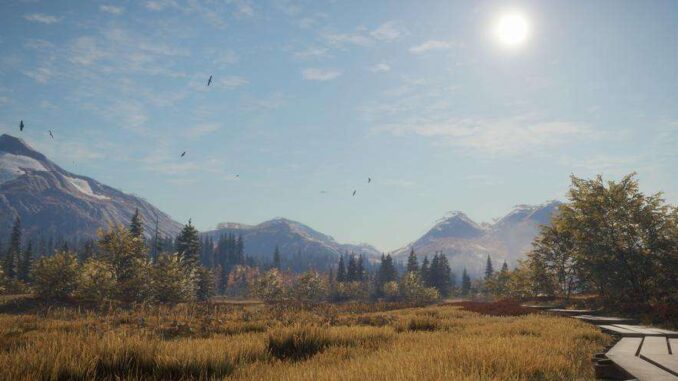
The basics of The Hunter: how to play the game, and how to hunt your first animal. I’ll go over controls, equipment, gameplay, and next steps.
Gameplay Basics
When you start a new game, you’re dumped into a wide open world with a rifle, some gadgets, and a voice in your head. No problem- let’s take stock of what you have.
Movement Controls
- WASD to move.
- E to interact.
- Ctrl to toggle crouch.
- Z to go prone. To exit prone, press Ctrl to crouch or press Space to stand.
- Hold Shift to move faster, at the cost of more visibility and lots more noise. You can move faster while crouched or prone as well.
- Space while standing to jump.
- G to automove. You can move sideways while automoving, but moving forwards or backwards will stop automove. You can also run while automoving. Great for long-distance stalking or travel.
Tool Controls
- F to use skills. You need to first equip active skills from either the Skills or Perks screen before you can use them. Active skills have a green background.
- L to turn on / off your headlamp. Your headlamp does not affect how easily animals spot you at night, so you can leave it on all the time. During nighttime, tracks are not highlighted unless your headlamp is shining on them. This means you have to look around to highlight tracks in the vicinity.
- 1-0 to select tools or weapons. To equip them, you have to drag them into the sidebar from the left. More on this later.
- Middle mouse button to toggle between scope and iron sights. Honestly, with the starting scope you should never need iron sights. The toggle is more relevant with weapons like the shotgun.
- Tab to toggle your HunterMate. This is your most useful tracking / stalking tool.
- P to switch to your camera. Used in some quests.
- H to holster / unholster your weapon. If you encounter the disappearing weapon glitch, this is how you get it back.
Map
Press M to access the map. You’ll see a variety of buttons and icons, and you’ll populate more as you explore the game world. Green icons are places you haven’t visited or activated, and white icons are those you’ve already been to.
While on the map, press H to travel to a different reserve.
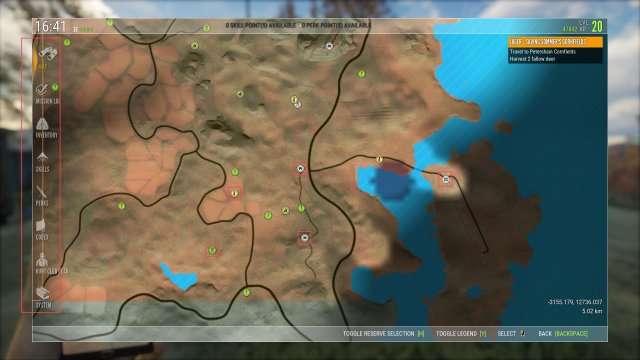
- Lookouts are marked with binoculars. When you first arrive in a reserve, they’re the only icons you will see. They reveal locations of interest around them.
- Outposts are marked with a little house. They are the most important locations, as they let you pass the time, buy and swap equipment, and fast travel.
- Need zones are marked with a water drop, a sleeping Zzz, or a leaf. They denote when a certain species of animal will be in that area fulfilling that need. Need zones are also tied to a specific time of day.
- The Shooting Range is a special location in the south-east of Hirschfelden. Inside the range, you have unlimited ammo and you can test your weapons at many target distances. I strongly recommend trying out your starting rifle here if you’re not confident in your shooting.
Game Screen
The game screen is simple, but it expresses everything you need to know.
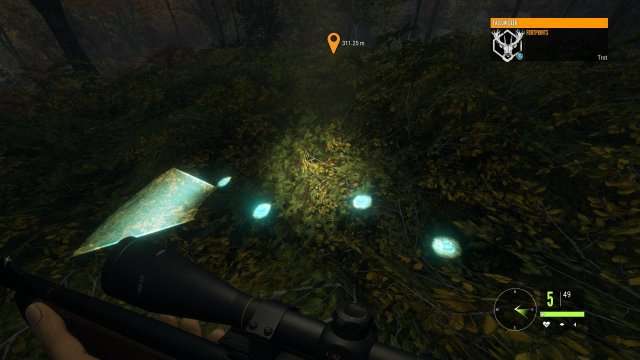
- Tracks glow white for animals you are not currently tracking, and blue for the animal you are currently tracking. Tracks also show a cone in the approximate direction the next track is. This is really just an approximate cone, and you should expect to find tracks that are far-off or at the edge of the cone. Note that you do not automatically track animals you shoot or down.
- When you interact with a track (press E), a small window pops up at the top-right of the screen showing you what species made those tracks and what gait they were moving at- walking, trotting, or running. Some skills increase the amount of information you gain from examining tracks.
- Other kinds of tracks include blood trails, which show you how much an animal is bleeding from a wound, and droppings, which show you how recently an animal was in the area. A quick chart of times can be found in the spreadsheet (linked below).
- When an animal makes a noise near you, you will see sound waves coming from a particular direction. Look at the sound waves and press E to see a summary of the species and kind of call.
HUD
The bottom-right of the screen contains a lot of information about your status.
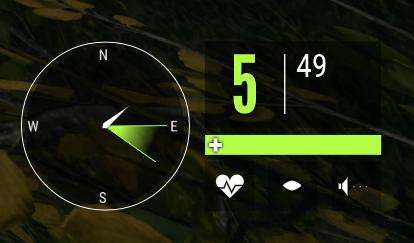
- The needle on the compass shows your current facing.
- The green cone on the compass shows the wind direction and speed. The narrower the cone, the faster the wind. This also shows you roughly what area your scent is being blown to, and how easily animals that are sensitive to smell can detect you.
- The big and small numbers show you how many shots you have in your weapon’s magazine, and how many you have in reserve.
- Below your ammunition count is your health.
- The heart shows how fast your heart is beating, and it turns red as you perform strenuous activity (holding your breath, running, jumping). The faster your heart beats, the louder you breathe and the more unsteady your aim becomes.
- To the right of your heart icon is your visibility indicator. A full circle means you are completely out in the open, while a short grey horizontal line means you are nearly invisible. Visibility can be reduced by crouching, going prone, and moving through vegetation. Animals which see you will be scared and run away.
- To the right of the visibility indicator is the sound indicator. As you make noise, the speaker bars will first fill up with white bars, then with red bars. Noise can be reduced by moving slower, especially when moving through vegetation. Again, animals which hear you will be scared and run away.
HunterMate
Your HunterMate is essentially an app on a smartphone that tracks your location, all the tracks you’ve seen so far, and any need zones / map features in your vicinity. It’s the most useful took you have when tracking animals. Press Tab to toggle the HunterMate.
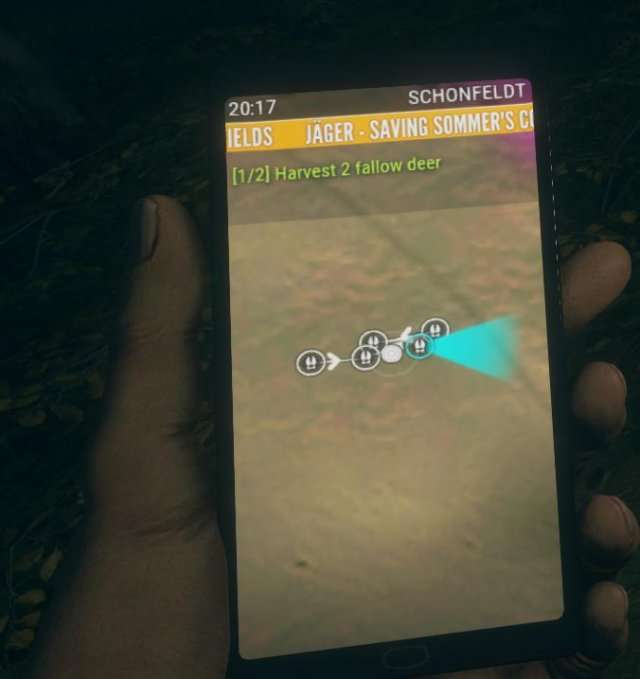
- Note how the animal I’m currently tracking has its tracks displayed in blue, and a blue cone showing its next direction.
- My HunterMate is connecting tracks with a line because of a skill I unlocked. When first starting out, your HunterMate won’t connect the dots for you.
Spreadsheet
Equipment
You start out with a variety of equipment. Learning how to use all of them will be key to success as a hunter. Your starting equipment is in fact very versatile, and will serve you many good hours into the game.
None of your equipment ever needs cleaning, maintenance, or refurbishment. Buy it once, it lasts forever (except for scents and ammunition, of course). Maybe that’s why they cost so much- you’re shelling out for the good stuff! Stainless steel barrels and actions, weatherproof and shockproof optics.
Binoculars
You start with a decent pair of binoculars with a great zoom and a good field of view. While looking at animals through a pair of binoculars, press E to spot them. The animal will be highlighted in blue, and you will see some basic facts about the animal you’ve spotted.
They are useful in the early game when you’re learning the various species, and also because the default rifle scope is difficult to look through. However, unlike in real life, as you gain skills and perks the binoculars (and rangefinders, when you unlock them) may get less and less useful.
Lures
There are three main kinds of lures- callers, scents, and decoys. Pay attention to the details for each lure- they have different ranges, attraction strengths, and effective times. Each kind of lure works only on one or two species, although you can get skills that increase their effectiveness.
You start with the deer bleat caller, the roe deer caller, and the musk deer scent. The bleat caller is useful in Layton, where it attracts blacktail and whitetail deer, while the roe deer caller is useful in Hirschfelden.
Callers are like little musical instruments. You play them, and they attract animals to you. Callers work by sound, and so are not affected by the wind- animals in a radius around you that respond to the caller are affected. They are unlimited use and last 90 seconds.
Scents are carried by the wind and so attract animals towards you from downwind. They generally last longer, about 200 seconds, but unlike callers they have limited uses.
There is a special scent eliminator that reduces (but does not completely eliminate) your own smell, which lets you sneak up closer to sensitive animals that are downwind of you.
Decoys (currently only Canada Geese decoys) are basically fake geese which you plant in a field. Geese are touchy creatures- if they see other geese already in the field, they’re more likely to feel that it’s safe, and land there.
Rifle
The rifle you start with is the Ranger .243. Get to know it well! It is a bolt-action rifle with a 5-round magazine, capable of pinpoint accuracy up to 150m in your hands from the very beginning of the game.
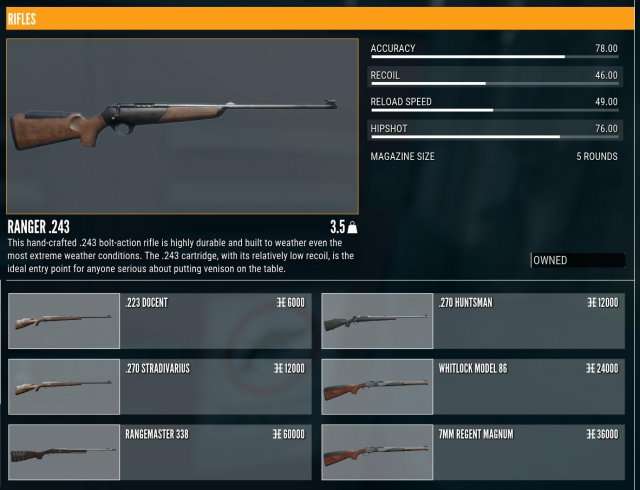
Unlike many other FPSs, in theHunter you are encouraged to take the time to consider your shot, and fire only when you are ready. Until you unlock the appropriate perk, you can only fire one round while looking down the sights- you have to lower the rifle to cycle the bolt and chamber another round before you can fire again. Even then, the recoil is relatively strong, the chambering time is long, and you have only 5 rounds in the magazine. This is definitely not a game about mowing down furry critters.
I strongly suggest looking for the shooting range in Hirschfelden when you start out so you can get used to handling your rifle. It’s on the lonely island in the far southeast, along the path right where it meets the island- you can’t miss it.
Sights
You start with the Ascent 1-4×24 rifle scope. It’s good enough for a starter scope. Remember that you can zoom in and out with the mouse wheel while looking down the scope, and you can toggle between scope and iron sights by clicking the mouse wheel.
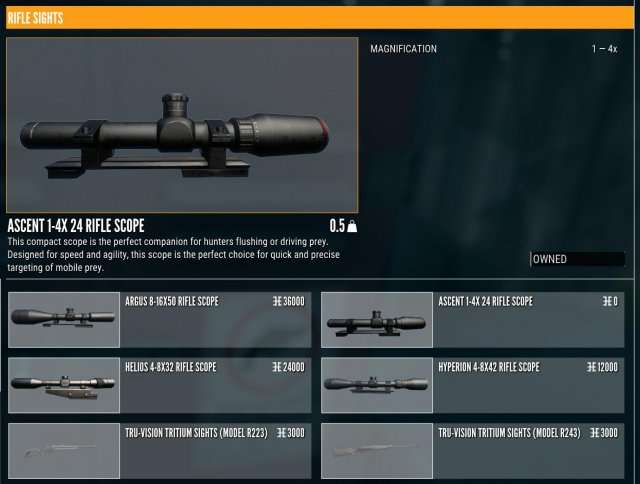
I suggest keeping it on all the time. The crosshairs are much easier to shoot with than iron sights. Even if you’re right up against your quarry, you can always zoom all the way out, and still have your pinpoint reticle.
Also, I suggest skipping the most expensive scope (Argus 8-16×50). It’s only useful in very specific scenarios, and makes it harder to take close range shots. The Hyperion 4-8×42 is a great scope for all uses.
Ammunition
You start with .243 soft point ammo. This is ammunition with a soft lead tip exposed- this lead tip mushrooms out upon hitting a target, creating a larger wound and doing more damage. However, this results in less penetration and worse aerodynamics, meaning a round that’s not as accurate and that falls quicker.

Nevertheless, out to 150m this round is lethal against everything it’s intended to be used against, and some more, with good shot placement. What’s even better is that this round is always free to buy.
You might be tempted to buy .243 polymer tip ammo when it becomes available. The bullet flies better, further, and penetrates better as well, meaning that you’re more likely to score a hit on a vital from a bad angle.
In real life, the polymer tip on such bullets in fact helps the bullet mushroom out, causing severe damage to soft targets. However in this game, polymer tips expand noticeably less than soft points.
Will you notice the difference? Not really. Ultimately shot placement is the most important. I shot polymer tips for a while (in the game. In real life, polymer tips are really good), then went back to soft points just because the ammo was cheaper.
As an aside, I’m almost disappointed they don’t stock FMJs so we can go full Karamojo Bell and reliably go for brain shots. But hey, you should never be taking brain shots anyway, unless you are in fact Karamojo Bell…
Quarry
It’s of utmost importance to learn about your quarry. What animal are you hunting? How does it behave? How sensitive is it to sight, scent, and sound? Where can you find it, at what times? Where are its vitals located? What is an appropriate caliber weapon to shoot it with? All these will become important to you at the various stages of the hunt- spotting, stalking, shooting, and skinning.
Go to the pause menu, select “Codex”, and click on “Wildlife”. Read up about the different kinds of game you’ll be pursuing. The weapon classes are all cattywampus- look at the spreadsheet instead.
Note that theHunter diverges from real life. Don’t take what works in-game as a sign that it works in real life! Always pay attention to the appropriate courses, do your research, and learn from those with experience.
Your first quarry will be medium-sized deer- roe and fallow deer in Hirschfelden, and blacktail deer in Layton Lakes. The .243 rifle is also suited to shooting coyote in Layton Lakes. Nevertheless, I suggest starting in Hirschfelden as there are fewer tempting distracting targets.
Behaviour
All animals are wary creatures. After millions of years of evolution and millennia of human hunting, they have evolved to be naturally skittish, and especially to fear humans. That means to get a good shot off, you will need to be real sneaky-like.
When they are going about their business, you will find them hanging around need zones, wandering about looking for mates, or simply resting. They will frequently stop to look up and look around. If you spot one before it spots you, immediately go to a crouch and move slowly.
In theHunter, they will react to seeing, hearing, or smelling you. Once they have detected you, they become wary of threats; they may sound a warning call, start moving to a different location, or flee outright.
Anatomy, or: getting to the heart of the matter

Your objective should be to down an animal as quickly as possible. For a beginner hunter (and in real life, for all hunters) that means a heart-lung shot. A bullet passing through one or both lungs will very quickly incapacitate an animal and drop it right where it stands.
This serves three purposes- first, it’s humane to kill an animal quickly. Second, it saves you the trouble of having to track down a wounded, bleeding animal. Finally, killing an animal quickly gives you more score, earning you more experience and money. You’ll want all of it!
The image above is of a roe deer, but all deer species have the same basic anatomy. The heart is highlighted in red, and the lungs are immediately above and behind the heart. Note the huge heart-lung area, right behind the front leg shoulder. Also note how thick the front leg is, and how much meat potentially can get in the way- you want to take the shot when the leg closer to you is in front, exposing the vitals. Especially since in theHunter, bullets don’t penetrate quite as well as they do in real life!
A good rule of thumb is to shoot behind the near front leg, about a third of the way up the chest.
Also note that I shot the heart from the front for this deer so that it’s easier to see for this guide, but I’ve presented the image sideways so you can see the preferred shot angle and the vitals- broadside, through the heart-lung area.
Spot
Spotting your quarry is the most important part of the whole process. You can’t shoot what you don’t know about! There are many ways to start yourself on the trail of an animal.
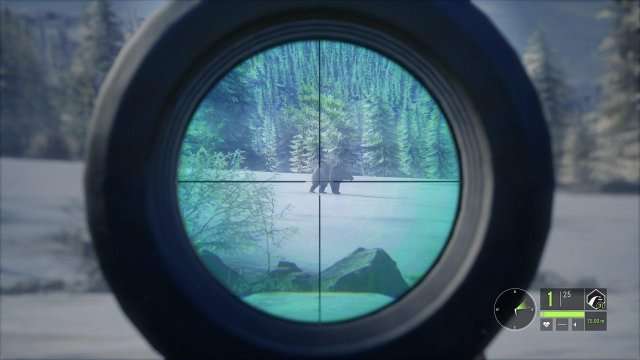
A brown bear spotted through the scope you start out with. Note that brown bear is found only in the MEDVED-TAIGA DLC.
Visual
The most obvious- and intuitive- way of spotting an animal is with your eyes. Chances are in the beginning while you’re bumbling about, making a lot of noise, and not paying attention to your surroundings, you’ll see more animals running away than going about their business. But keep it up, and soon it’ll be second nature spotting a tiny blur of movement through the bushes.
Spotting an animal has another great advantage- you know where it is exactly, and you can judge the distance to it. If it hasn’t spotted you yet, you’re essentially on your final approach! Crouch down or go prone depending on how much cover there is, watch the wind, and find a good position to take a shot from.
Even if the animal spooks and flees, it usually won’t run far- you can track it down and try again.
One thing to note- animals that are too far away will not be drawn on-screen, but they’ll still be there. If you’re looking across a wide open space, take out your binoculars, or simply look through your scope / iron sights. You might find some animals suddenly “popping” into existence when you do that. They’ve been there all along, it’s just that they’re so far away that the game doesn’t draw them.
Sound
Sound is a vastly important part of the theHunter experience. You rely on sound to tell you of approaching game, calls, and your own noise level. If game is close enough, you can literally hear their footsteps- with a pair of headphones you can turn to face them even if you can’t see them.
So- turn the music off, turn the volume up, and put on headphones. You’ll find the immersion a lot better, and your tracking / stalking results improve.
Tracks
Tracks are all over the place, but interpreting them is difficult. What you’re looking for is 3 pieces of information:
- How long ago was the animal here?
- Where did it head towards?
- Was it aware of me?
Between droppings and trails, you will get all of this information. Once you spot a dropping, examine it to see how long ago it was “made”. Fresh or just now? The animal is close. Very old? You might want to find another trail.
Animal Calls
Animal calls are another great source of information. They mean that an animal is close by- close enough that you can hear it. If you have earphones on, you can determine roughly how far away they are, based on how clear / murky their call is.
There are two kinds of calls- mating calls, and warning calls. Warning calls mean that the animal has sensed that something is amiss. Most of the time they won’t flee right away, but they’ll be on guard. This is both a good and a bad thing! It means that an animal is close by, but also means that you have to move very carefully.
A mating call is a sign that you can use a caller to attract that particular species, or simply stalk it. Again, judge how far away it is, and plan your stalk accordingly.
Stalk
Stalking is the art of following a deer stealthily with the objective of killing it. Stealth really is key to the whole enterprise, though being able to follow a trail is naturally a requirement as well. This means that patience and care are traits well-rewarded.
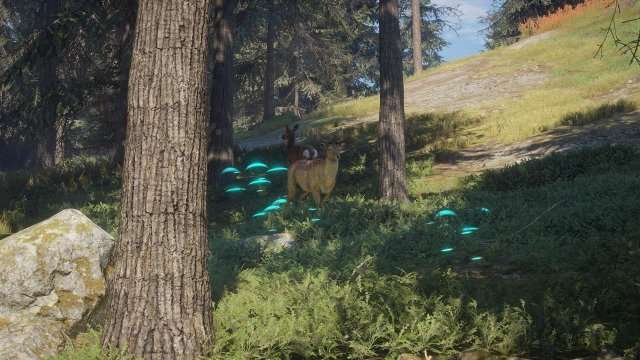
Proper stalking lets you get extremely close to your quarry.
Tracking
As mentioned in the Spot section, you are going to spend most of your time following trails.
Droppings are your best way to judge if a trail is worth following, and how quickly you should move along a trail. Droppings that were made “just now” mean that the animal is extremely close- you should crouch immediately, move slowly, and pay attention to your surroundings. If you used a caller or scents, you might want to stay completely still and listen for footsteps. On the other hand, droppings that are “very old” are more than half an hour old- you might want to go after different quarry instead.
Trails show you the direction your quarry was traveling in, and their gait at the time, i.e. whether they were walking, trotting, or running. Walking or trotting is normal behaviour. Running means they spotted you and are most likely aware of you. Note that many animals like to flee downwind, making pursuit even more difficult- now they can smell you too.
Stealth
Movement always generates noise, and is always more easily seen than just staying still. However, you have to move faster than your target if you want to catch up with it. Thankfully, a fast crouch (with the run button held) will make you faster than most quarry in the game, and you’ll catch up with them after some time.
When you’re on the trail and you know you’re near, fast crouching offers a good balance between speed and detection. As you get close, or immediately when you hear a warning call, you should slow crouch- you’ll notice you start making a lot less noise.
Going prone is another great option when an animal is extremely flighty, or when you’re already close. Moving while prone is the stealthiest option, but also puts you close to the ground, making it sometimes very difficult to get a good shot. I’ve found a slow crouch to be the best way to get close enough to take a good shot- just remember to stay inside shrubs to reduce your visibility.
With enough points into skills, stalking will get easier as you generate less noise and become less visible.
Scent
The last thing you have to keep track of is your scent, and this is very simple- simply stay downwind of your target. Simply look at your compass- if your heading needle (the white needle) is pointing inside the green wind cone, chances are that the animal you’re following will be able to smell you.
Sometimes stalking an animal downwind works, and sometimes it doesn’t. If you’re not finding any success, try turning upwind and stalking an animal in that direction instead. If you know you won’t lose the trail, it might be worthwhile to circle around and approach from a different direction so you aren’t directly upwind of your quarry.
Shoot
You’ve stalked your quarry. It’s in sight. You’re close, downwind, and it’s broadside. Time to take the shot. This is where all that practice pays off. Again, I strongly recommending spending some time at the Hirschfelden range to familiarize yourself with your weapon and sights, and the way it operates.
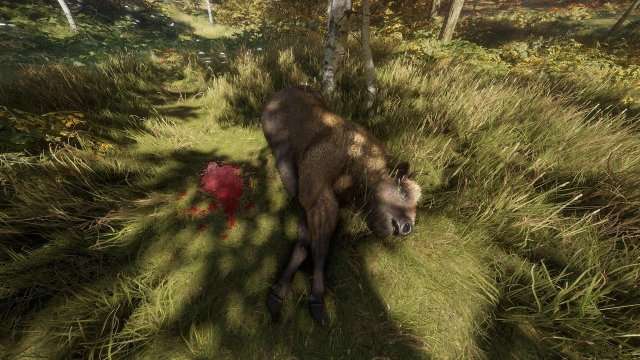
A bison, properly shot through the lungs. The massive blood splatter indicates that it was hit in a vital organ. It fell where it stood.
Weapon handling
Spot the animal with your binoculars if you want to. This highlights it in blue and makes its contours easier to visualize, as well as showing its outline through foliage. It’s very helpful when starting out.
Hold the right mouse button to aim down your sights. There’s almost no cause in the game to shoot from the hip! Always aim your shots, and take the time to aim.
Click the middle mouse button to toggle your scope on or off. With the starting scope, you shouldn’t need to take it off- simply zoom all the way out if the target is extremely close.
Use the mouse wheel to control scope zoom. Pick a zoom level you’re comfortable with, and that will let you put a bullet right where you want it to go. If you’re zoomed in all the way and you still aren’t comfortable with the shot, you’re too far away.
All weapons will sway while you’re aiming down them. It’s natural. You’re not the Master Chief! Hold Shift to hold your breath, which drastically steadies your aim. However, you can only do it for so long, and only when your heart rate is normal. Practice holding your breath and aiming, and get used to how much time you have to shoot.
After you shoot, you will cycle the action of your rifle. This takes time, and in the beginning, means a follow-up shot is out of the question. Make the first one count! Pick a weapon of the appropriate caliber. Since you’re just starting out, you’ve picked quarry that your weapon is suitable for- fallow deer, roe deer, or blacktail deer.
Finally, hit R to reload your weapon.
Anatomy / Shot placement

Remember our earlier lesson? Let’s review it. You’ll want to place your shot into the heart-lungs area, from a broadside shot of the animal. You want to avoid shooting through thick muscle and especially avoid shooting through bone. This means you should look to take a shot at the animal’s broadside, and put it about a third to halfway up the chest, behind the front leg.
Great distances will affect how you place your shot, but within 100m- you should not shoot any further than this for now, and in fact try to get as close as you can- no compensation for bullet rise or drop is necessary. Wind also won’t be a factor at this distance.
There are some no-nos. Unlike other FPSs, do not go for head shots. It’s very difficult to penetrate the skulls of most animals, and you’re very likely to miss and hit the jaw instead- which is not a lethal kill. Imagine a deer running around with its jaw flapping in the wind. You should never be the cause of something like that.
If the animal is quartering- not directly sideways or head-on, but turned slightly towards or away from you- you could still try to take the shot. Quartering away (animal is facing away from you) is a little easier than quartering towards (animal is looking at you), but of course broadside is always preferred. When quartering away, use the animal’s leg further away from you as a reference instead of the nearer leg. When quartering towards, use the front of the shoulder of the nearer leg as a reference.
Since you’re starting out, you might want to simply wait for a broadside, then take the time to examine the animal’s x-ray after you harvest it.
An animal facing away from you is a gigantic no-no in real life. Same for when the animal is facing towards you. Learn proper shot placement first. In theHunter, as you get better, you may become more confident in taking spine shots. There are many guides that show you how to do those, but in this guide I’ll only teach you the proper heart-lung area shot.
Pulling the trigger
Stabilize yourself. Stop moving, secure a firing position- either crouched or prone, avoid shooting standing.
Hold your breath. Steady your aim.
Squeeze the trigger gently. In thHunter as in real life, jerking on the trigger will throw your aim off-course. Squeeze it slowly and purposefully.
Observe
Don’t release your aim yet. Look at the animal. Remember where you shot it. Did it fall where it stood? If not, which direction did it run off in?
If it ran off, you will need to stalk it all over again. It’s good ethics to never leave an animal running around wounded- put it out of its misery.
If you downed an animal, you will notice a purple circle area on your HunterMate and your map around the area where the first bullet hit it. This is hunting pressure, and it shouldn’t affect you for now- just note that, if you’re ever doubting if an animal died from one of your shots, look for the hunting pressure to appear as soon as it dies.
Skin
Sometimes an animal doesn’t die where it stands. It runs away, and takes some time to bleed out. If it dies, you will see hunting pressure appear- purple circle area on your HunterMate and your map centered on where it first got shot.
Look out for bloodstains. These are clear signs that you hit an animal. When you examine a bloodstain and it glows blue instead of white, then you know that you’re on the trail of the right animal. Look for tracks that show the animal running- that means it was fleeing after it took the bullet. You may have to track it for a very long time! A large splatter means that you hit a vital organ, but doesn’t mean the animal will die very quickly- the size of the next splatter will tell you how fast it’s losing blood. And if you leave a dead animal unharvested, that’s unethical in real life, and in theHunter it is penalized by you forfeiting any accumulated consecutive harvest bonus.
Tracks are sometimes interrupted. If you cannot find the next set of tracks, broaden your search area. It’s usually enough to simply look a little further to the left or right, but sometimes you need to start at a known track (most commonly a blood splatter) and move in an ever-widening circle to look for the next blood splatter. The cones are generally accurate, but many tracks are at the edge or slightly out of the edges of the cones.
If it’s at night, make sure your headlamp is on!
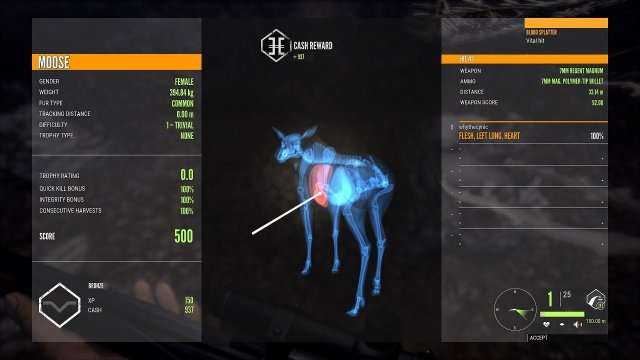
Once you find the downed animal, you will see it lying in a pile. It will glow blue. Move closer until you see the prompt to interact with it. Congratulations, you’ve harvested your first animal!
Don’t hit “accept” immediately. Take the time to look at the screen. This will be the best learning experience for you. You can see where your shot(s) landed on the animal. You’ll get an x-ray of the animal in the pose the bullet hit it in, which is useful for anatomy lessons but especially useful for learning how the animals move. You can click and drag the x-ray to look around.
On the left, you’ll see several ratings- quick kill, integrity, and consecutive harvest. Quick kill simply means how quickly the animal died after you shot it. Integrity means how appropriate your weaponry was for the quarry. If you used a rifle that was too powerful, or shot it too many times, you will lose integrity bonus.
Finally, the consecutive harvest bonus is awarded for each animal you down and harvest, and you lose it when you down an animal but don’t harvest it. (It’s perfectly acceptable to down multiple animals, as long as you harvest all of them). It drives home the importance of taking responsibility for your shots!
Next Steps
Congratulations! You’ve successfully shot your first deer. It took a lot, but all the lessons you’ve learned go directly to your next hunt.
As you hunt, you might want to take on different kind of game. You’ll want bigger rifles (at first, at least), better sights, and better lures. You’ll wonder what skills and perks to get.
What’s your playstyle? Are you more of an ambusher, relying on calls and scents? Or are you a stalker, stealthily creeping through the woods?
I personally am more of a deerstalker. I got the Stalker skills that improve my stealth, and the skill that lets my HunterMate connect the dots. Most of my perks so far have been rifle perks.
Note that the Zeroing perk will be useless until you’re shooting at very long range, or if you’re hunting with bows- within 150m, your rifles shoot essentially flat, and the short-range zero is useless for rifles.
Try out polymer-tip ammo and see if it works better for you. If you want a new scope, the 4-8x scope is better than the 8-16x, since you’ll only rarely be shooting at really long ranges. A .270 rifle is a very decent first purchase, and puts you in the running for much bigger game. A .223 rifle is useful only if you plan to shoot lots and lots of Canada geese and red fox. Avoid the lever-action rifles until you’re more familiar with the game- there’s just not enough money to splurge on everything.
The inventory system is actually very simple. You have 2 storage locations- your stash, shared between all outposts, and your backpack, which you carry with you. So after buying something, you need to move it from your stash to your backpack. This is done from inside the “Backpack” tab in the outpost menu.
Once something is in your backpack, you still need to assign it to a hotkey in order to use it. If you’re equipping a weapon, you must assign it ammunition, and optionally assign it sights. Yes, you can re-use a single sight for multiple rifles! This is done from the “Inventory” screen in the pause menu.
Have fun, and good hunting!
Bugs and Fixes
The Hunter is a relatively new game- it has many bugs, some worse than others.
Weapon disappears
- Sometimes your weapon disappears. Your HUD changes, but you don’t see it in your hands, and you can’t aim with it. This happens usually when switching between items very quickly. To fix this, hit the Holster hey (H) twice.
Weapon keeps reloading after aiming down sights
- This is extremely irritating for single-shot rifles, and usually happens after a session at the shooting range. Unfortunately there is no fix for this that I’ve found other than actually shooting a round of ammo.
Geese
- Geese are horribly bugged. Sometimes (especially during rain) you’ll see solo geese fly really slowly and not go anywhere. Don’t shoot these, unless they’re literally right in front of you and you have a deer rifle- they’re invulnerable at long range to the usual weapons. There’s no fix for these other than leaving and rejoining the game.
Map doesn’t load
- It takes some time. Give it a couple of seconds for the textures to load properly.


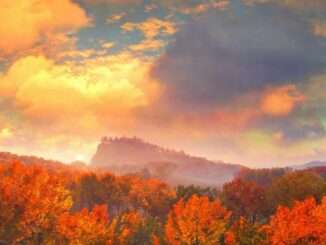
New pack, largest made will not hold more. Any ideas.
I got 243 ammo but it will not reload to my gun. What do I need to do??
Great write up. I read using flashlight at night doesn’t increase your visibility, and shooting from a treestand doesn’t increase pressure. Just started playing today and totally hooked! Wish there was a time indicator and a nicer design for the upgrades, like an old sears style catalogue or something:)
Great work! It helped me a lot, even tough i had some experience at the time of reading it! Thank you very much!
How do you save a game?